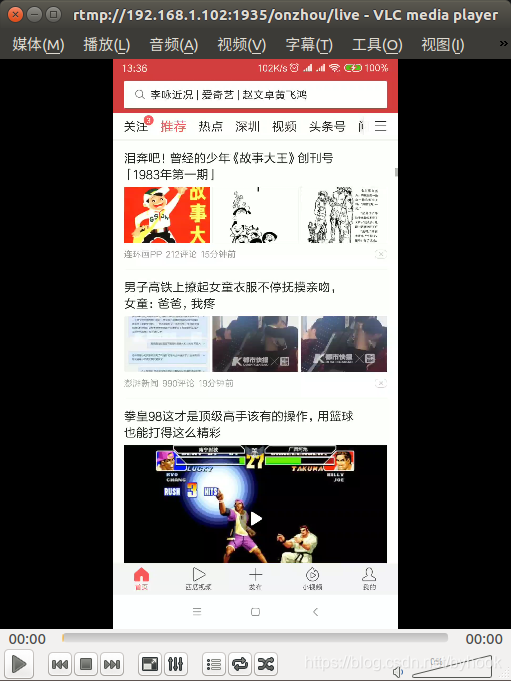android全平臺編譯ffmpeg視訊推流實踐
阿新 • • 發佈:2018-11-06
ffmpeg實踐學習
- android全平臺編譯ffmpeg以及x264與fdk-aac實踐
- ubuntu下使用nginx和nginx-rtmp-module配置直播推流伺服器
- android全平臺編譯ffmpeg合併為單個庫實踐
- android-studio使用cmake編譯ffmpeg實踐
- android全平臺編譯ffmpeg視訊解碼器實踐
- android全平臺編譯ffmpeg支援命令列實踐
本文目錄
概述
還是先從最簡單的搞起來,先從最基本的視訊推流開始,要知道在電腦上使用ffmpeg
ffmpeg的推流命令即可,今天想在android平臺實踐一下,具體操作大家也可以看看雷神的部落格。
ffmpeg -re -i input.mp4 -vcodec copy -f flv rtmp://192.168.1.102:1935/onzhou/live
配置環境
作業系統: ubuntu 16.05
注意: ffmpeg庫的編譯使用的是android-ndk-r10e版本,使用高版本編譯會報錯。
而android-studio工程中配合cmake使用的版本則是android-ndk-r16b版本

新建工程ffmpeg-single-streamer

-
build.gradle配置比較簡單,可以參考之前的文章 -
新建
CMakeLists.txt檔案,配置如下
cmake_minimum_required(VERSION 3.4.1)
add_library(ffmpeg-streamer
SHARED
src/main/cpp/ffmpeg_streamer.c)
find_library(log-lib
log)
#獲取上級目錄
get_filename_component(PARENT_DIR ${CMAKE_SOURCE_DIR} - 新建
NowStreamer.java檔案
package com.onzhou.ffmpeg.streamer;
public class NowStreamer {
static {
System.loadLibrary("ffmpeg");
System.loadLibrary("ffmpeg-streamer");
}
public native int startPublish(String input, String output);
}
- 在
src/main/cpp目錄新建原始檔ffmpeg_streamer.c
#include <jni.h>
#include <stdio.h>
#include <time.h>
#include "libavcodec/avcodec.h"
#include "libavformat/avformat.h"
#include "libavfilter/avfilter.h"
#include "libavutil/log.h"
#ifdef ANDROID
#include <android/log.h>
#include <libavutil/time.h>
#define LOG_TAG "NowStreamer"
#define LOGE(format, ...) __android_log_print(ANDROID_LOG_ERROR, LOG_TAG, format, ##__VA_ARGS__)
#define LOGI(format, ...) __android_log_print(ANDROID_LOG_INFO, LOG_TAG, format, ##__VA_ARGS__)
#else
#define LOGE(format, ...) printf(LOG_TAG format "\n", ##__VA_ARGS__)
#define LOGI(format, ...) printf(LOG_TAG format "\n", ##__VA_ARGS__)
#endif
//輸出日誌
void log_callback(void *ptr, int level, const char *fmt, va_list vl) {
//寫入日誌檔案
FILE *fp = fopen("/storage/emulated/0/av_log.txt", "a+");
if (fp) {
vfprintf(fp, fmt, vl);
fflush(fp);
fclose(fp);
}
//LOGE(fmt, vl);
}
JNIEXPORT jint JNICALL Java_com_onzhou_ffmpeg_streamer_NowStreamer_startPublish
(JNIEnv *env, jobject obj, jstring input_jstr, jstring output_jstr) {
AVOutputFormat *ofmt = NULL;
AVFormatContext *ifmt_ctx = NULL, *ofmt_ctx = NULL;
AVPacket pkt;
int ret, i;
char input_str[500] = {0};
char output_str[500] = {0};
char info[1000] = {0};
sprintf(input_str, "%s", (*env)->GetStringUTFChars(env, input_jstr, NULL));
sprintf(output_str, "%s", (*env)->GetStringUTFChars(env, output_jstr, NULL));
//日誌回撥寫入檔案
av_log_set_callback(log_callback);
av_register_all();
//網路初始化
avformat_network_init();
//Input
if ((ret = avformat_open_input(&ifmt_ctx, input_str, 0, 0)) < 0) {
LOGE("Could not open input file.");
goto end;
}
if ((ret = avformat_find_stream_info(ifmt_ctx, 0)) < 0) {
LOGE("Failed to retrieve input stream information");
goto end;
}
int videoindex = -1;
for (i = 0; i < ifmt_ctx->nb_streams; i++)
if (ifmt_ctx->streams[i]->codec->codec_type == AVMEDIA_TYPE_VIDEO) {
videoindex = i;
break;
}
//Output
avformat_alloc_output_context2(&ofmt_ctx, NULL, "flv", output_str); //RTMP
//avformat_alloc_output_context2(&ofmt_ctx, NULL, "mpegts", output_str);//UDP
if (!ofmt_ctx) {
LOGE("Could not create output context\n");
ret = AVERROR_UNKNOWN;
goto end;
}
ofmt = ofmt_ctx->oformat;
for (i = 0; i < ifmt_ctx->nb_streams; i++) {
//Create output AVStream according to input AVStream
AVStream *in_stream = ifmt_ctx->streams[i];
AVStream *out_stream = avformat_new_stream(ofmt_ctx, in_stream->codec->codec);
if (!out_stream) {
LOGE("Failed allocating output stream\n");
ret = AVERROR_UNKNOWN;
goto end;
}
//Copy the settings of AVCodecContext
ret = avcodec_copy_context(out_stream->codec, in_stream->codec);
if (ret < 0) {
LOGE("Failed to copy context from input to output stream codec context\n");
goto end;
}
out_stream->codec->codec_tag = 0;
if (ofmt_ctx->oformat->flags & AVFMT_GLOBALHEADER)
out_stream->codec->flags |= CODEC_FLAG_GLOBAL_HEADER;
}
//Open output URL
if (!(ofmt->flags & AVFMT_NOFILE)) {
ret = avio_open(&ofmt_ctx->pb, output_str, AVIO_FLAG_WRITE);
if (ret < 0) {
LOGE("Could not open output URL '%s'", output_str);
goto end;
}
}
//Write file header
ret = avformat_write_header(ofmt_ctx, NULL);
if (ret < 0) {
LOGE("Error occurred when opening output URL\n");
goto end;
}
int frame_index = 0;
int64_t start_time = av_gettime();
while (1) {
AVStream *in_stream, *out_stream;
//Get an AVPacket
ret = av_read_frame(ifmt_ctx, &pkt);
if (ret < 0)
break;
//FIX:No PTS (Example: Raw H.264)
//Simple Write PTS
if (pkt.pts == AV_NOPTS_VALUE) {
//Write PTS
AVRational time_base1 = ifmt_ctx->streams[videoindex]->time_base;
//Duration between 2 frames (us)
int64_t calc_duration =
(double) AV_TIME_BASE / av_q2d(ifmt_ctx->streams[videoindex]->r_frame_rate);
//Parameters
pkt.pts = (double) (frame_index * calc_duration) /
(double) (av_q2d(time_base1) * AV_TIME_BASE);
pkt.dts = pkt.pts;
pkt.duration = (double) calc_duration / (double) (av_q2d(time_base1) * AV_TIME_BASE);
}
//Important:Delay
if (pkt.stream_index == videoindex) {
AVRational time_base = ifmt_ctx->streams[videoindex]->time_base;
AVRational time_base_q = {1, AV_TIME_BASE};
int64_t pts_time = av_rescale_q(pkt.dts, time_base, time_base_q);
int64_t now_time = av_gettime() - start_time;
if (pts_time > now_time)
av_usleep(pts_time - now_time);
}
in_stream = ifmt_ctx->streams[pkt.stream_index];
out_stream = ofmt_ctx->streams[pkt.stream_index];
/* copy packet */
//Convert PTS/DTS
pkt.pts = av_rescale_q_rnd(pkt.pts, in_stream->time_base, out_stream->time_base,
AV_ROUND_NEAR_INF | AV_ROUND_PASS_MINMAX);
pkt.dts = av_rescale_q_rnd(pkt.dts, in_stream->time_base, out_stream->time_base,
AV_ROUND_NEAR_INF | AV_ROUND_PASS_MINMAX);
pkt.duration = av_rescale_q(pkt.duration, in_stream->time_base, out_stream->time_base);
pkt.pos = -1;
//Print to Screen
if (pkt.stream_index == videoindex) {
LOGE("Send %8d video frames to output URL\n", frame_index);
frame_index++;
}
//ret = av_write_frame(ofmt_ctx, &pkt);
ret = av_interleaved_write_frame(ofmt_ctx, &pkt);
if (ret < 0) {
LOGE("Error muxing packet\n");
break;
}
av_free_packet(&pkt);
}
//Write file trailer
av_write_trailer(ofmt_ctx);
end:
avformat_close_input(&ifmt_ctx);
/* close output */
if (ofmt_ctx && !(ofmt->flags & AVFMT_NOFILE))
avio_close(ofmt_ctx->pb);
avformat_free_context(ofmt_ctx);
if (ret < 0 && ret != AVERROR_EOF) {
LOGE("Error occurred.\n");
return -1;
}
return 0;
}
推流伺服器的搭建,可以參考之前的文章
public void onStartClick(View view) {
if (nowStreamer == null) {
nowStreamer = new NowStreamer();
}
if (publishDisposable == null) {
publishDisposable = Schedulers.newThread().scheduleDirect(new Runnable() {
@Override
public void run() {
//推流本地的一個mp4檔案
final File intputVideo = new File(getExternalFilesDir(null), "input.mp4");
nowStreamer.startPublish(intputVideo.getAbsolutePath(), PUBLISH_ADDRESS);
}
});
}
}
編譯打包執行,開始推流,我們在區域網中使用vlc播放器,開啟網路串流
rtmp://192.168.1.102:1935/onzhou/live

專案地址:
https://github.com/byhook/ffmpeg4android
參考雷神:
https://blog.csdn.net/leixiaohua1020/article/details/47056051
